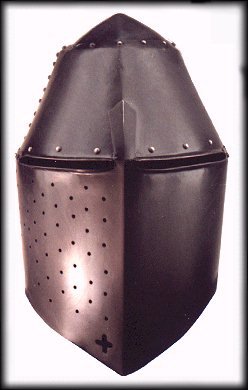This page is dedicated to the armor worn throughout the 14th century. I am far from an expert on this topic so I have relied on many sources located in the Bibliography. If there are any problems with the content of the body of this text please feel free to contact me through the email provided on the Copyright page. All images have been graciously donated for use in this text in the spirit of knowledge and largesse.
At the outset of the 14th Century we see the increased use of plate armor. One way of ascertaining the armor currently being used is through the inspection of 14th century Wills and sales receipts. One such Will outlined many items such as gambesons, mail hauberks, basinets, padded cuisses, half and full greaves, and a coat of plates. The Coat of Plates could of evolved from the 13th Century plated surcoat. The majority of the knights present at the battles of Cre’cy and Poitiers fought in Coats of Plates. By the late 1320's we see the knight "wearing three layers of body-armour. Over his shirt he wore the long-sleaved aketon, over which went his hauberk, and on top of this a body-armour called 'a pair of plates'" (Norman 84-85).
The Great Helm was worn over the basinet in war and tournament up to, or about 1350. After 1350 the Great Helm was not used as frequently for war and was relegated to the tournament fields. The great helm was attached to the body armor by a guard chain. This chain ran to a toggle fitted into a cruciform hole provided on the front of the helm. Two good examples are the remaining helmet of the Black Prince (Fig 1), and the Pembridge Helm (Fig. 2). The Pembridge helm hung over the tomb of Sir Richard Pembridge (d.1375) in Hereford Cathedral.
(Fig. 1) (Fig. 2) (Fig.3) (Fig. 3a)
When the Great Helm fell out of use in war the Basinet was fitted with a visor. The first of these visors was the Globular Visor that hung from a hinge on the right side of the helmet. During the first stages of visor development the Germans and Italians developed a padded triangular plate that ran from that aventail to a central helm mount (fig. 3, 3a). Latter the Klappvisor came into use. One example of the Klappvisor style can be found in the Museum of Sitten, Switzerland. A modern replica of the Klappvisor is provided in (fig. 4a,b).
(Fig. 4a) (Fig.4b)
The leg armor of the 13th Century consisted of gamboised (padded) cuisses, poleyn (knee cop), and schybald, (shin-defense) or greaves with no back plate. I have provided a hand rendering of these in (fig. 5). The original picture can be found in Gravett’s The world of the Medieval Knight , Pg.18. By the late 14th century the Cuisses were studded with rivets attached to metal plates under the material, not unlike the brigandine coat that came in to use in the late 1300s. The greave also started to have metal strips riveted to them in Germany and Italy. I have provided a hand rendering of this newer style in (fig. 5). By the end of the 14th Century the leg defense was made entirely of steel plate. We also see the use of plate sabatons as well as the continued use of Mail and studded leather sabatons. |







